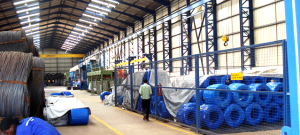Higher steel prices hurt builders

The overall annual rise in input prices was a result of noticeable increases registered in steel bars by 6.9 percent and roofing sheets by 4.8 percent.
February 16-Uganda’ construction sector, already burdened with high debt, also had to grapple with a shortage of steel towards the end of last year that adversely affected operations.
Dick Wanasolo Wadada, a Principal Statistician at the Uganda Bureau of Statistics (UBOS) said, “The overall prices of steel in the different markets have been going up due to the absence of steel in the different markets and this was worsened by big market suppliers like China going on a break.
“This means that there was less steel going around for all the construction work that was taking place,” he said.
He was presenting the latest data on prices. He said Uganda has been witnessing higher costs in the construction sector. There were sustained price increases for steel, roofing sheets, electrical equipment, diesel and wages in October 2016 with a 1.0 percent rise, a 0.1 percent for the period ending November 2016 with the period of December 2016 registering a 1.1 percent increase compared to the period ending December 2015.
“This means that on average, one had to pay 1.1 percent higher for a given selection of inputs into construction works in December 2016 than in December 2015 for the same basket,” Wadada said.
He said the overall annual rise in input prices was a result of noticeable increases registered in steel bars by 6.9 percent and roofing sheets by 4.8 percent. He said this was due to increased costs of production and rising world steel prices.
Prices for electrical wires and cables rose by 2.2 percent and on aggregate by 5.6 percent due to hikes in transportation costs and demand which saw an increase in price inputs for both residential and commercial buildings.
Prices for inputs for residential buildings saw an increase of 2. 8 percent, following a price increase in concrete products by 16.1 percent. There were also increased production costs for roofing sheets by 2.8 percent, aggregate demand by 5.6 percent and wages by 2.7 percent. Workers cited higher costs of living. Non-residential buildings registered a 0.7 percent increment in input prices of 0.7 percent and roads gravel by 0.6 percent.
Wadada said unless domestic steel manufacturing picks up quickly, it is unlikely the construction sector will get any relief from high prices until about April or May when more steel is available and Chinese imports are off-loaded.

 Commuter bus operator Tondeka Metro loses city commuter business in web of intrigue
Commuter bus operator Tondeka Metro loses city commuter business in web of intrigue
 100+ Accelerator selects Ugandan startup Yo-Waste to pilot glass recycling at Nile Breweries
100+ Accelerator selects Ugandan startup Yo-Waste to pilot glass recycling at Nile Breweries
 Boeing’s record SAF purchase supports airlines decarbonisation efforts
Boeing’s record SAF purchase supports airlines decarbonisation efforts
 Uganda Airlines likely to miss Spirit A320neo delivery slots
Uganda Airlines likely to miss Spirit A320neo delivery slots
 Rolls-Royce Pearl 10X engine takes flight
Rolls-Royce Pearl 10X engine takes flight
 Unpacking results-based financing: balancing strengths with weaknesses
Unpacking results-based financing: balancing strengths with weaknesses
